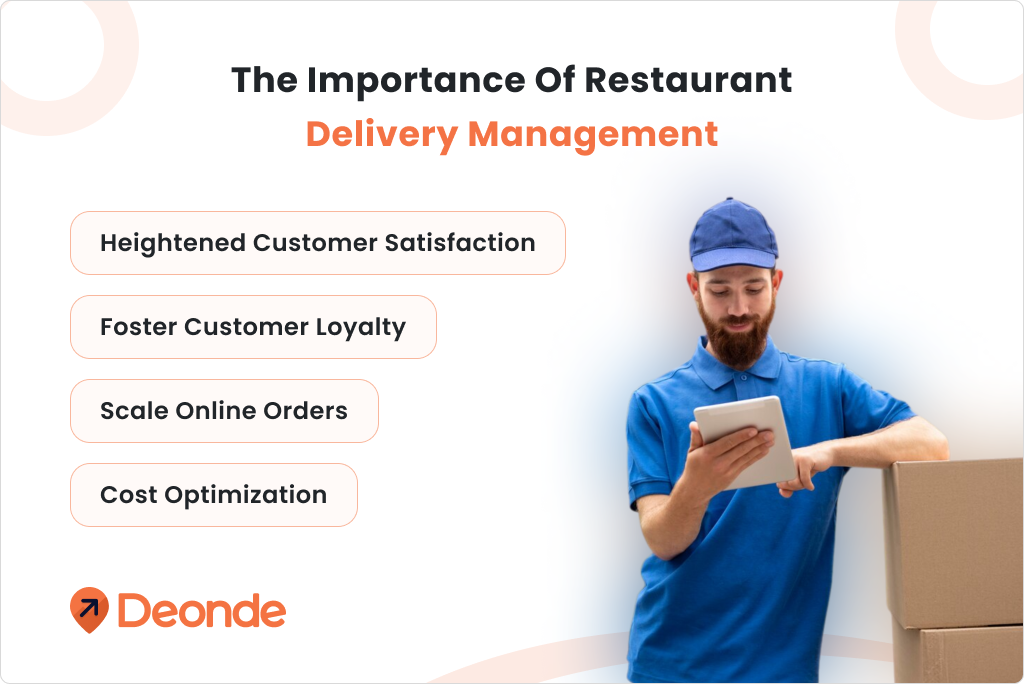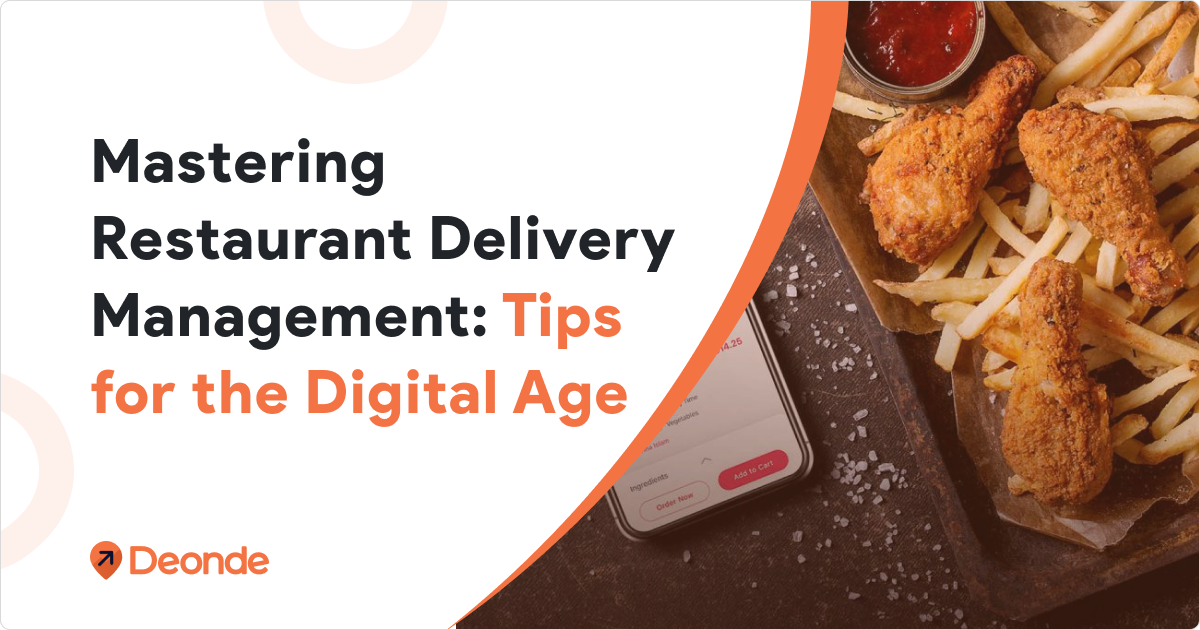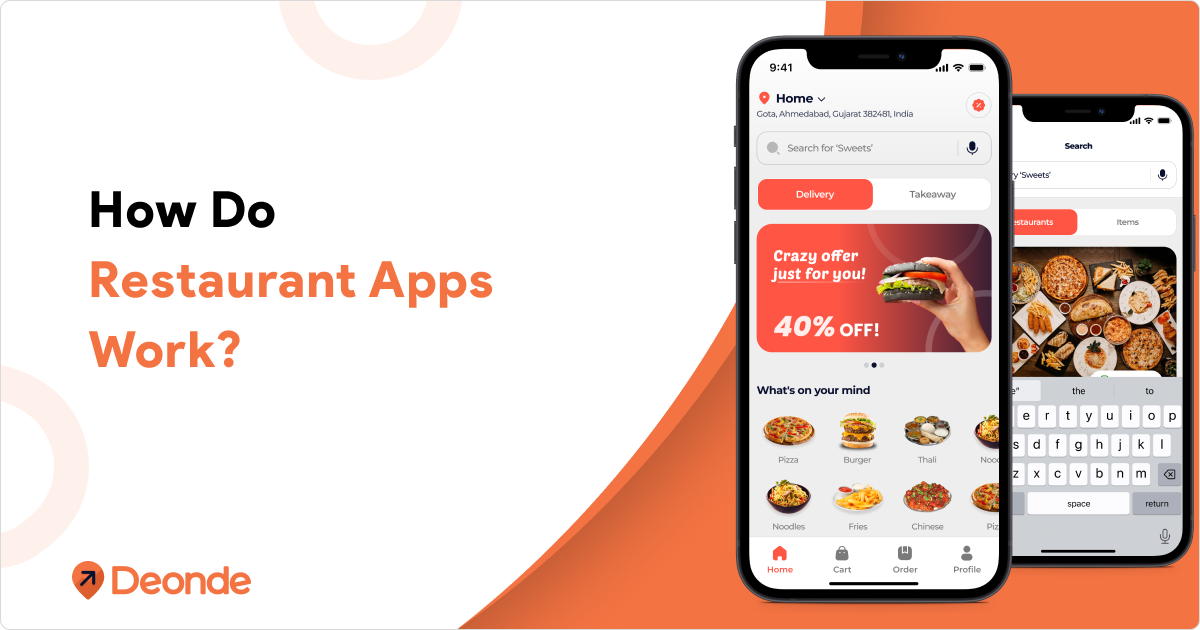Introduction
Running a restaurant in this economy is like walking on a tightrope.
While there are several ordering and delivery platforms available to boost online sales, none of them will be good enough if you don’t have the upper hand in delivery management.
Imagine this—
You’re a restaurant owner, and with the right strategies and a food delivery system, you’ve nailed online food ordering.
Large volumes of orders are pouring through every day.
But now what?
Have you prepared your kitchen to handle both online and offline customers?
Have you streamlined backend processes like POS, transactions, staff, and order delivery?
If not, don’t worry, because through this blog, you’ll receive actionable insights on managing high-volume orders and mastering restaurant delivery.
We’ll discuss some of the most proven techniques for helping you survive and thrive in this competitive landscape by boosting your bottom line and restaurant food delivery processes.
What Is Restaurant Delivery Management?
Restaurant delivery management is a subset of food delivery management.
The only difference is—the onus of timely food deliveries is now on the shoulders of the restaurant owner and not an app aggregator.
Meaning, any delays or errors in order fulfillment will directly reflect on your restaurant’s brand image.
Restaurant food delivery management, in general, refers to the process of fulfilling online orders through streamlined delivery and inventory tracking.
It entails efficient management of the kitchen, staff, delivery drivers, delivery routes, and customer communication.
Think about this: Why are customers exclusively ordering from your restaurant food delivery app?
Because they love your food and service, and in this digital era, it’s important to meet consumer demands and expectations—even when you’re serving them online.
Hence, we at Deonde believe that restaurant food delivery management is the most crucial aspect of skyrocketing online restaurant sales.
The Importance Of Restaurant Delivery Management
So far, we’ve explored the importance of managing delivery, especially if you’re receiving orders through your very own restaurant food delivery app.
We spoke about how delivery management directly affects the restaurant’s brand image and online sales.
And yet, the importance of delivery management for restaurants cannot be stressed enough.
Hence, in this section, we’ll be talking about the impact of restaurant delivery management on sales, customer satisfaction, and OpEx optimization.

- Heightened Customer Satisfaction
Errors in order processing, delays, and lack of proper communication can cause customer dissatisfaction. Errors, delays, and other operational inefficiencies arise only when you don’t have a restaurant delivery management system in place.
Not taking the time to optimize delivery operations will aggravate customer dissatisfaction and depreciate sales.
With so many competing restaurants, you need a USP (unique selling point). So, let delivery management be that key differentiator for your restaurant. With clear item descriptions, customization options, and real-time updates, restaurants can significantly reduce order mistakes and enhance customer satisfaction.
- Foster Customer Loyalty
A happy customer is a customer for life.
Once you’ve mastered delivery management and regularly processed error-free orders on time, you can think about fostering a community of customers.
Today, 92% of top-performing restaurants use mobile restaurant delivery apps to facilitate orders and customer loyalty. How? By offering loyalty points for all customers who order through the restaurant app instead of a multi-vendor food delivery app like Zomato or Uber Eats.
Doing so not only incentivizes repeat ordering but also gives new customers a compelling reason to order from the restaurant’s app.
Another advantage of fostering a community of customers is that you can track their preferences and leverage that data to further boost delivery convenience. For instance, offer contactless deliveries for younger customers who usually don’t prefer calls or physical interactions to further enhance convenience.
By understanding customer preferences, you can optimize your delivery process to drive customer loyalty and repeat orders.
- Scale Online Orders
You can not only scale sales but also cater to a wider audience once you’ve optimized your online delivery processes.
Work on creating a seamless experience, from browsing menus to customizing the cart and payments. Doing this will allow you to acquire more online customers across different geographies.
As you reach a wider audience, you’ll also need to drive backend operational efficiency to meet the rising demands. You can achieve that by training your delivery drivers and teaching them to do order batching to deliver more orders without making multiple trips. You can also optimize delivery routes and geofence delivery zones for quicker delivery.
Implementing this technique will allow you to accelerate current operations, allowing you to focus on expanding your services and generating more revenue.
- Cost Optimization
Lack of delivery management is hurting you in more ways than one.
Not only is it inhibiting restaurant growth, but it is also eating away at a chunk of your net profits.
An inefficient delivery system can lead to unwanted overheads and operating expenses (OpEx). For instance, a customer returns their order because you sent them the wrong food items. In this case, your staff will have to rework the order. Needless to mention, the waste of raw food inventory.
While these costs may appear negligible right now—they add up over the month.
By evaluating your current system, you can identify areas for improvement and areas where technology can be used to automate and accelerate workflows.
Mastering delivery management is a sure way to reduce labor costs, overheads, and waste.
So, streamline operations to boost profitability. Delivery management will help you drive more mileage out of your current resources, orders, and customers.
How to Master Your Restaurant Delivery Management?
There are numerous advantages to using a delivery management solution for your restaurant. But optimizing and taking charge of your delivery operations is easier said than done.
But don’t worry—in this section, we’ll delve into the best practices for optimizing delivery management for your restaurant.

- Integrate Your Existing POS with Deonde Ressto
In order to get started, you first need to connect your existing point of sales channel to a restaurant delivery solution that facilitates online ordering and delivery.
While there are many options, we recommend using a SaaS-based white-label application like Deonde Ressto. Deonde Ressto is pre-built, meaning you can get started with it almost instantly. It’s also customizable and will allow you to maintain our brand integrity, logo, colors, tagline, and more.
Additionally, Deonde Ressto is a comprehensive solution that can handle end-to-end ordering workflows. It has a customer ordering portal, a vendor management portal, and a driver/delivery person portal, which enables easy and efficient communication across the board.
Deonde Ressto is a leading food delivery solution for restaurants. With a 99.99% server uptime, 27/7 tech support, and regular updates, the system will set you up for success.
- Make the Most Use of Your Restaurant Delivery Software
After integrating a restaurant delivery system, you need to make sure you get the most out of it. Hence, it is pivotal to get acquainted with the delivery software’s functionalities and design workflows that work for you.
Here are a few features that are particularly important to delivery management:
- Menu Optimization
The key to restaurant delivery management is creating a dynamic menu that can support customization. The menu should be easy to update and have logical categories to help users quickly find what they’re looking for.
Deonde Ressto offers a menu management module. Through this, restaurant owners can add their dishes, descriptions, and high-resolution pictures of the food. The menu management in Deonde Ressto works well with the Inventory management module—so restaurant owners can keep track of their kitchen inventory and restock promptly.
- Order Management
After optimizing your restaurant menu, the next step is familiarizing yourself with the order management functionality. Here, all orders placed through the interface will be visible. This module allows you to track order times, customer preferences, and average order values. You’ll also be able to pass order receipts to the kitchen to accelerate food preparation.
- Delivery Management
The delivery management module allows restaurant owners or managers to keep track of deliveries on any given day. The admins also get insights into past deliveries in case of disputes or refunds.
The delivery management module is a great tool for understanding how many orders are getting placed through the app and how much time is taken by the delivery staff to fulfill these orders.
- Driver Management
Deonde Ressto allows admins to store, edit, and manage driver details like personal information, ID proof, work hours, earnings, trips completed, and more. Having visibility into these stats allows for proper resource planning and allocation. You can also designate specific areas for the delivery drivers to aid the food delivery process further.
- Offers and Rewards
The restaurant manager or owner can utilize the dashboard access to update the different festival offers that are automatically updated on the restaurant’s connected devices. These offers benefit both dine-in and food-delivery customers.
- Streamline Ordering Process
Make sure your users don’t have to go through a lot before they can place orders or confirm delivery. Minimize the number of steps and eliminate all unnecessary fields.
Having a complex process for ordering and delivery may dissuade customers from placing more orders. If you’re dealing with a lot of abandoned carts, then you may need to review our ordering and delivery process from the user’s point of view.
- Delivery and Pickup Options
Offer flexible delivery and pickup options to make it easier for customers to receive food deliveries. Enable customers to provide clear delivery instructions with each order. For instance, provide an option of “don’t ring the bell” or “leave at the doorstep” for maximum convenience.
- Real-time Delivery Tracking
Offer real-time order status updates to let customers know where their order is at any given time. Real-time tracking offers peace of mind to your users as they can exactly tell when they’ll get their food delivered without having to call the delivery driver or the restaurant. This is why a lot of customers today appreciate the ability to track their orders in real-time.
Insider Tips: How to Optimize Your Restaurant Delivery System?
Assuming you have a restaurant ordering and delivery system, here are a few things you can do to further optimize delivers and make sure your customers get steaming hot food every time:

- Create a Separate Online Menu
Offer more value to the customers ordering online. Create a different menu for online sales and clearly mention your restaurant’s specialty or new dishes here. Clearly distinguish your virtual brand’s menu from your main restaurant menu to avoid confusion.
Also, offer rewards or loyalty points to customers ordering online. Invesp’s market study claims that customers are 53% more likely to order online when offered a discount code. Make use of his consumer psychology tactic and offer limited-time deals to boost orders. You can also boost promotional offers and codes through push notifications, social media, and in-app messaging.
- Secure Your Payment Gateways
Ensure thorough security while processing payments to encourage more users to make payments online.
If your payment gateways are broken or prone to security break-ins, your customers will hesitate to order through your app. This will affect your sales and brand image.
Evaluate Customer Experience
Assess the user experience of your online ordering system from start to finish. Always stay updated with key analytics like average order value, repeat rate, revenue generated, estimated profits, delivery times, and driver efficacy.
Use this data point to streamline your services and offer your restaurant app and users a more cohesive online ordering and delivery experience.
Mobile Ordering Optimization
Most customers today are ordering through their smartphones. Hence, ensure your online delivery system is mobile-optimized. Make sure you send delivery updates via the ordering app or other messaging channels like SMS, WhatsApp, or email. Always confirm the user’s phone number so delivery partners can call them if they need help with directions.
Needless to say, ensuring the app is responsive and easy to navigate on mobile screens will greatly boost the entire delivery and ordering process.
Customer Feedback and Reviews
Provide a platform for customers to leave feedback and reviews on your online ordering and delivery system. Ideally, you should actively monitor and respond to feedback to address concerns and continuously improve the ordering and delivery experience. An additional feature to focus on is the delivery driver rating. Customers should be able to rate their food and delivery experience separately. Hence, you get a clear idea of where your services are lacking.
Conclusion
In this fast-paced world of technology, you really need the right set of software systems in place to get ahead of the curve.
If you truly want your restaurant to thrive in this market, invest in a good food delivery system like Deonde.
Once you have a digital interface for your restaurant, think of ways you can optimize its workflows to get a little more bang for your buck.
Using a delivery management system would be a start.
Using the techniques and industry insights mentioned in this blog, you’ll introduce efficiency and impact to your online ordering and delivery management process.
And the benefits of restaurant delivery management are simply priceless. Restaurant delivery management can help you foster client loyalty, boost online sales, and improve your brand perception.
Besides, an optimized delivery management system will be your key differentiator in this competitive space, where new restaurants are going digital every day.
We at Deonde help restaurant owners expand their business online by connecting them to a ready-to-use white-label restaurant order-taking app integrated with a delivery management solution.
So, take the competitive edge and boost your sales with Deonde.
FAQs
What is Restaurant Food Delivery Management?
Restaurant food delivery management means optimizing delivery processes to increase online sales, customer satisfaction, and brand engagement through a delivery management system. Through restaurant delivery management software, restaurant owners can streamline processes like delivery tracking, delivery assignment, driver management, and more.
How can I Master Restaurant Delivery Management?
Invest in delivery management software like Deonde Ressto and avail features like order management, driver management, delivery management, and online order tracking. With these tools, you can maximize customer satisfaction and optimize restaurant processes for greater returns and profits.
What are the Benefits of Delivery Management Software for Restaurants?
There are numerous advantages to getting started with a delivery management solution, like heightened customer satisfaction, greater customer loyalty, upscaling, expansion, cost optimization, and revenue growth.
What Features Does Deonde Ressto Provide for Seamless Restaurant Deliveries?
Deonde Ressto is equipped with functionalities that can accelerate delivery processes for on-time deliveries. This includes driver management, delivery zoning, driver settlements, customizing shipping costs, and order management. To try these out, connect with Deonde.





